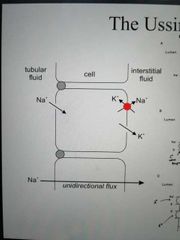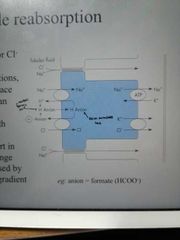![]()
![]()
![]()
Use LEFT and RIGHT arrow keys to navigate between flashcards;
Use UP and DOWN arrow keys to flip the card;
H to show hint;
A reads text to speech;
25 Cards in this Set
- Front
- Back
|
The kidneys use a system of reabsorption whereby they remove everything from the plasma, only to add it back in later. Why do they do this instead of just secreting the waste products? |
Because there are fewer solutes that need to be reabsorbed than the potentially infinite amount of things that would need to be excreted, therefore fewer types of channel are required for reabsorption and it is more energetically favourable |
|
|
Describe the Ussing model of vectorial Na transport |

The NaKATPase pumps 3Na out for 2K in, creating a Na gradient. The K is recycled via a K rectifier channel, and the Na is imported through the apical membrane via a Na channel |
|
|
What is absorbed by the proximal tubule and by which mechanisms? |
Na, Cl, HCO3, Ca, glucose, amino acids using carriers Water by osmosis K, Ca, Mg by solvent drag |
|
|
What is secreted into the proximal tubule and by which mechanism? |
Organic anions and cations by carriers |
|
|
What is absorbed in the descending loop of Henle, and by which mechanism? |
Water through aquaporins |
|
|
What is absorbed in the ascending loop of Henle and by which mechanisms? |
Na, Cl, HCO3 by carriers Na, K, Ca, Mg by paracellular route |
|
|
What is absorbed by the early distal tubule, by which mechanism? |
Na, Cl using carriers |
|
|
What is absorbed by the late distal tubule and collecting duct, through which mechanisms? |
Na, water using channels Urea using carriers |
|
|
What is secreted into the late distal tubule/collecting duct, by which mechanisms? |
H+ using carriers K using channels |
|
|
How is the proximal tubule divided? |
Into 3 regions, S1, S2, S3. S1/2 comprise the proximal convoluted tubule, S3 is the straight tubule |
|
|
What specialisation is found on the apical border of the cells of the proximal tubule? |
Brush-border microvilli |
|
|
The transport of ions and solutes is facilitated by which ion? |
Sodium |
|
|
Which isoform of SGLT is present in S1 and S2? |
SGLT2 |
|
|
Which isoform of SGLT is present in S3? |
SGLT1 |
|
|
What is Tm and what happens if you exceed it? |
The Transport Maximum for a particular molecule. It represents the maximum rate of reabsorption for that molecule, and if your plasma contains too much of that molecule it will start to be excreted in the urine |
|
|
What are the 4 channels responsible for amino acid reabsorption? Which AAs are reabsorbed by each one? |
Cationic (basic) - lys, arg, his, sys Anionic (acidic) - asp, glu Neutral - ala, val, leu, ser, thr Glycine and imino acids - gly, pro, hydroxypro |
|
|
Describe the pathway of HCO3 reabsorption |

1. Vectorial Na influx due to Ussing model is coupled to H+ eflux through apical membrane via a Na-H exchanger. H+ is also removed through the apical membrane via H+ ATPase 2. H+ in tubular fluid react with HCO3- via carbonic anhydrase to form CO2 and water, which are drawn into the cell. 3. More carbonic anhydrase reverses the reaction to reform HCO3- and H+ inside the cell. The H+ is recycled 4. The HCO3- is removed from basolateral membrane via NBC (Na-Bicarbonate co-transporter) |
|
|
What are the two pathways of chloride reabsorption? |
Paracellular across leaky junctions Transcellular via anion exchange mechanism |
|
|
Describe the anion exchange mechanism of Chloride reabsorption |

1. Vectorial Na influx due to Ussing model is coupled to Na-H+ exchanger which removes H from apical membrane. 2. H+ in tubular fluid reacts with anions eg formate to form neutral substance, eg formic acid. 3. Formic acid diffuses passively back into cell and splits into H+ and anion. H+ is recycled 4. Anion is used to drive Cl- influx via antiport system 5. Cl- is removed from basolateral membrane via K-Cl symport protein |
|
|
Describe the process of calcium reabsorption |
1. Calcium influx mediated by ECaC (channel) in apical membrane 2. Can be removed either by Ca ATPase in or NCX in basolateral membrane |
|
|
Which substances stimulate calcium reabsorption? |
PTH, calcitriol (vit D derivative) |
|
|
What is PAH? What can it be used for? |
para-amino hippurate It can be used to assess renal blood flow |
|
|
What is the transepithelial voltage in S1? |
-2mV |
|
|
What is the transepithelial voltage in S2/S3? |
+2mV |
|
|
The plasma and tubular fluid have no discernable difference in osmolality, ie they are isotonic. If this is the case, how can water be reabsorbed? |
There are indeed very small differences in osmolality. Because the proximal tubule is so highly permeable to water, small differences can still exert large osmotic gradients |

